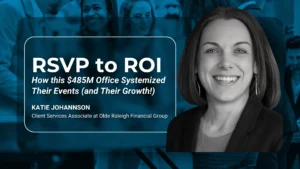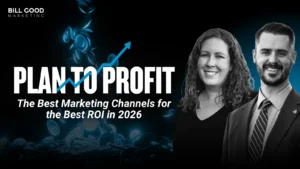“Is it better to serve 500 clients—or just 50?”
That’s a question we’ve been asked by thousands of financial advisors over the last 45+ years. And every time, we smile—because it’s not really the right question.
Sure, the number of clients you have plays a role in your success. But it’s not about how many. It’s about which clients you serve… and how well you serve them.
Here’s the hard truth: we’ve seen advisors with 500 clients barely scrape by. And we’ve seen advisors with 50 high-net-worth clients thriving—bringing in more revenue, building stronger client relationships, and actually enjoying their business.
Of course, we’ve the seen the reverse be true, too.
At Bill Good Marketing, we’ve spent decades helping financial advisors, RIA firms, and broker-dealers build businesses that don’t just survive—but scale sustainably. We’ve studied the numbers, tested the strategies, and worked alongside some of the most successful practices in wealth management and financial planning.
And what we’ve learned is this: The ideal number of clients isn’t a fixed number. It’s a function of your ideal client, your client service model, and your ability to deliver quality of service consistently—without burning out or dropping balls.
In this guide, we’re going to break down the real numbers. We’ll show you what works and what doesn’t for independent financial advisors and advisory firms who want to grow smarter, not just bigger.
Because the goal isn’t “more clients.” It’s more of the right clients. It’s building a business where your time, energy, and expertise go toward serving the clients who value you most—and reward you for it.
Let’s dig in.

The Real Average: What the Numbers Say (And Don’t Say)
Let’s start by addressing the number everyone talks about.
You’ve probably heard it: “The average financial advisor works with somewhere between 50 and 150 clients.”
Sounds reasonable, right?
But here’s what no one tells you: “average” is meaningless if you’re not an average advisor.
Over the last 45+ years, we’ve coached financial advisors at every level—from new advisors building from scratch, to certified financial planners (CFPs) managing billions in AUM. And across those 45+ years, we’ve seen a wide spread in client counts.
The number of active clients you can—and should—serve depends entirely on the type of clients you’re attracting, and therefore the services you must provide.
- Are you working with everyday investors who need frequent financial advice and handholding?
- Or are you focusing on high-net-worth clients and need to operate on scheduled investment management and financial planning reviews?
- Maybe you’re targeting small business owners or retirees with complex needs?
A CFP® practitioner managing $20 million in assets under management (AUM) across 100 clients has a completely different reality than an advisor managing $200 million across 40 clients.
In fact, one of our top-performing firms built a wildly profitable financial advisory business with just 37 individual clients. Why? Because they focused exclusively on clients with over $5 million in investable assets—and built their client service model around deep, proactive relationships, rather than volume.
So, while a Kitces’ research or industry report might say “50–150 clients” is the norm, that’s just a baseline.
Your “right number” depends on your goals, your niche, your expertise, your team capacity, and your desired level of service.
And here’s the kicker: more clients doesn’t always equal more revenue. Fewer clients doesn’t always equal a strong business.
We’ve seen plenty of financial advisors stacking hundreds to thousands of clients onto their books—and their phones never stop ringing. Their calendars are packed. Their admin load is crushing.
Meanwhile, their quality of service drops. Their best clients start to notice. And worse? They don’t have the bandwidth to pursue new clients. They don’t have the clients to leverage into landing those big referrals that could change their business.
In other words: too many clients can cost you money.
That’s why top financial advisors—and the smartest firms we work with—don’t chase “average.”
They chase alignment: aligning their client base to their business model, their capacity, and their personal goals.
Segmentation Is the Secret: It’s Not Quantity, It’s Quality
Here’s something we’ve learned after 45+ years helping financial advisors build better businesses:
You don’t need more clients. You need the RIGHT clients—and the RIGHT SYSTEM to serve them.
At Bill Good Marketing, we call this the difference between being “busy” and being “effective.”
Too many financial advisors are caught in the trap of thinking growth means adding more clients to their book. But the truth is, the more names you pile on without a system, the more diluted your service becomes. And when client service drops, so does retention, referrals, and future growth.
That’s why the best advisors don’t just serve “whoever shows up.”
They segment.
They prioritize.
They build a client service model that delivers the right level of attention to the right client’s needs at the right time.
When Bill Good first introduced client segmentation back in the 80s, most financial advisors followed the old-school approach: labeling clients A, B, or C. It worked functionally, but it wasn’t enough to distinguish where your time was best spent.
That’s why we pioneered a better approach: using the names of precious stones to classify clients.
Diamond, Emerald, Ruby, Sapphire.
Each stone communicates value.
Each tier sounds prestigious.
Each client still feels special—because they’re being associated with something inherently valuable.
And here’s why that matters:
- Clients stay loyal when they feel appreciated.
- Clients refer more when they feel prioritized.
- Clients consolidate assets when they trust you’re taking care of them.
In our System:
- Diamond clients get your highest level of service: personalized meetings, proactive outreach, tailored communications, and VIP experiences.
- Emerald and Ruby clients get thoughtful, consistent service—structured in a way that respects both their needs and your time.
- And Sapphire clients? They still receive quality service, but through more automated channels, freeing you up to focus on your core relationships.
One financial advisor we worked with came to us exhausted—juggling nearly 300 individual clients with no segmentation, no structure, and no bandwidth for new clients.
After we helped him implement the precious stone segmentation model, he narrowed his dedicated focus to about 70 households. He elevated service for his Diamonds and Emeralds, and introduced automation to manage communications with his Rubies and Sapphires.
What happened?
- Referrals from his Diamond segment became more frequent
- His Emerald clients started bringing friends to his events
- His Sapphire clients still felt “in touch” from his automated marketing.
- And for the first time in years, he left the office before 6 p.m.
Because here’s the secret: you don’t need more clients—you need the right clients, served the right way.
Segmentation isn’t about cutting people off. It’s about designing a client service model that ensures every client gets care and attention—without draining your time, diluting your service, or limiting your ability to grow.

When Financial Advisors Have Too Many Clients
Let’s be honest: Having too many clients sounds like a good problem—until it’s not.
We’ve seen it play out hundreds of times. An advisor grows fast, adds more clients, takes every referral that comes in, says “yes” to every new account. Suddenly, they’re managing 250… 300… even 400 individual clients.
But here’s what happens behind the scenes:
- Meetings start getting sporadic or by client request only.
- Follow-ups slip through the cracks.
- Rebalancing gets delayed.
- Calls and emails go unanswered.
- The “white glove” client service you promised starts to fade.
And clients notice.
The best ones—the ones who generate the most revenue, refer the most people, consolidate assets—notice first.
We call it “silent attrition.”
Clients don’t always fire you with a dramatic phone call. Sometimes, they just quietly move new assets to another advisor. Or stop referring. Or disengage.
That’s why too many clients can actually cost you money.
If you’re stretched so thin you can’t provide proactive financial advice, if you’re playing defense instead of offense, you’re not just risking client retention, you’re leaving growth on the table.
Here are three red flags that you’ve got too many clients:
- You haven’t proactively contacted a third of your clients in the last 6 months.
- You’re spending more time putting out fires than creating opportunities.
- You have no time for new clients, lead generation, or cultivating referrals.
When you’re overloaded, your business becomes reactive instead of strategic. And that’s where growth stalls. The solution isn’t “work harder.” It’s to work smarter.
Good financial advisors solve client overload in three ways:
- Review the numbers. Not every client contributes equally. Look at each client’s assets under management (AUM), revenue, and referral potential. Of course, we also have a COI and Contributor score to really understand who your best clients are.
- Communicate transitions. Some clients can be transitioned to another advisor, to a different service tier, or handled through increased automation and support staff.
- Restructure your model. Build a segmented, scalable client service model (like we teach at BGM) so you can focus on your most valuable relationships.
Every hour you spend on a client who doesn’t align with your business is an hour you’re not deepening relationships with your A-tier Diamonds. Every seat filled by a prospect who’s not ideal is a seat you can’t give to the prospect who is.

How to Grow Without Overloading Yourself
When advisors think about growing their business, the first instinct is often to add more clients.
More meetings. More accounts. More names in the CRM.
But here’s what we’ve seen again and again: piling on more clients doesn’t automatically equal more growth. In fact, it often leads to the opposite—overload, burnout, and a business running you instead of the other way around.
True growth isn’t just about adding clients. It’s about adding the right clients. The ones who align with your values, your goals, and your business model. The ones who bring meaningful assets, who value your expertise, who refer their friends, family, and colleagues.
Advisors who grow smarter—not just bigger—do a few things differently.
First, they get clear about their ideal client. Are they focused on high-net-worth individuals? Retirees? Small business owners? Real estate investors? Knowing exactly who you serve best—and want to serve—lets you tailor your messaging, your services, and your prospecting efforts. Have you created your ideal client personas? You should.
Second, they build marketing systems designed to attract those ideal clients. This might include strategies like:
- Social media campaigns on LinkedIn that showcase your expertise.
- Educational content marketing to position you as a trusted resource.
- Referral campaigns that encourage introductions from existing clients.
- Targeted cold calling to qualified leads.
- Lead generation funnels that bring prospects to you rather than chasing them.
Third, they make space for those clients by protecting their time. They’re not spending their best hours on clients who don’t fit their ideal profile. Instead, they’ve built a structure—whether through automation, delegation to support staff, or a segmented client service model—that keeps their business running efficiently without sacrificing quality.

Bottom Line: Find Your Number, Build Your System
So, how many clients should a financial advisor have?
It depends.
The “right” number of clients isn’t some magic figure pulled from an industry average or research report. It’s the number that allows you to deliver excellent client service without sacrificing your health, family time, or professional standards.
It’s the number that keeps your client relationships strong, your team engaged, your systems sustainable, and your revenue aligned with your goals.
For some advisors, that might be 250 clients across multiple tiers, supported by automation and a full support staff. For others, it might be 100 high-net-worth families receiving highly personalized financial advice. And for a few, it might be an ultra-niche practice managing complex real estate, business, or retirement assets for 50 individual clients.
It’s not about chasing volume for the sake of volume. It’s about aligning your client base with your capacity, your values, and your vision.
Here are three questions to help you find your number:
- What level of service do you want to provide? If you promise concierge, white-glove care, your client count needs to reflect the time that requires.
- What revenue do you want to generate? How many clients—and at what level of assets under management (AUM)—does it take to hit your income and business goals?
- What kind of business do you want to build? Do you envision a large team with layers of advisors? A boutique solo practice? Something in between?
Every advisor’s answer will look different.
But the advisors who answer those questions honestly—and build a business that supports their answers—are the ones who stay in this business for the long haul.
Because in the end, growth isn’t about “more.” It’s about building a practice that works for you, serves the right clients, and lets you enjoy the life and career you set out to build.
The good news? You don’t have to figure it out alone. There are proven systems, strategies, and frameworks to help you grow smarter, not harder.
The first step is getting clear on what growth really looks like for you.
A Proven System to Serve Fewer Clients, Better
If you’re reading this and thinking, “This all sounds great—but where do I start?” you’re not alone.
For over 45 years, we’ve worked with registered investment advisor (RIA) firms, independent broker-dealers, and a number of wirehouse financial service firms across the country, helping them answer that exact question.
We’ve helped new advisors grow from zero.
We’ve helped veteran advisors transition to a more focused, profitable client base.
We’ve helped financial advisory teams implement client service models, segmentation strategies, and marketing systems that let them scale without sacrificing quality.
At the heart of it all?
A proven system. A repeatable process. A roadmap for growing your business with fewer clients, more assets, and better relationships.
At Bill Good Marketing, we help you:
- Identify and attract your ideal clients through smart, sustainable lead generation strategies.
- Build a client service model that delivers the right service to the right clients at the right time.
- Implement automation and workflows so you and your support staff spend less time on admin and more time on what moves the needle.
- Create a marketing strategy that positions you as the go-to advisor in your niche, whether you’re targeting high-net-worth individuals, retirees, small business owners, or other specialized demographics.
The result?
- More referrals.
- More assets under management.
- More time to focus on what you love.
And a business that serves both your clients and your life.
If you’re ready to stop guessing and start building a practice designed for sustainable growth, let’s talk. Because the best time to take control of your client count isn’t someday. It’s today.
Click here to schedule your free strategy session or call us at 888-495-7303 to learn how we can help you build the business you’ve always envisioned.
About the Author

Andrew D. White is the Director of Marketing at Bill Good Marketing and part of the team behind Altitude, the AI-native CRM built exclusively for financial advisors. He develops marketing strategies that strengthen client relationships, accelerate asset growth, and reduce time spent in the office. With hands-on experience working alongside top advisors, Andrew focuses on proven systems that elevate prospecting, branding, and practice management into predictable growth engines.




